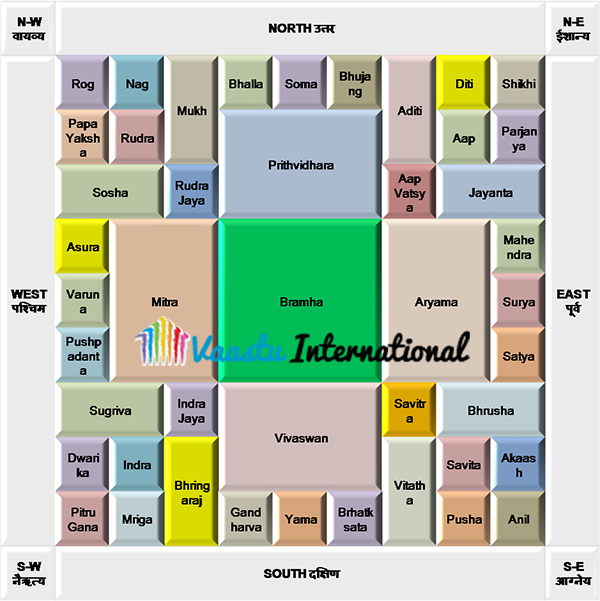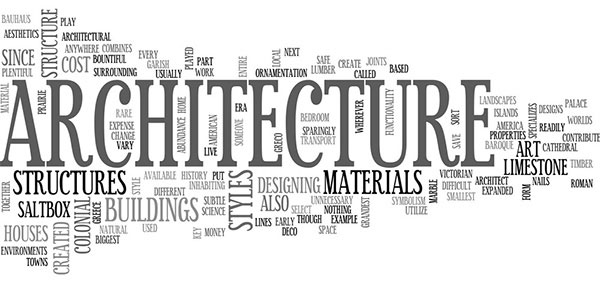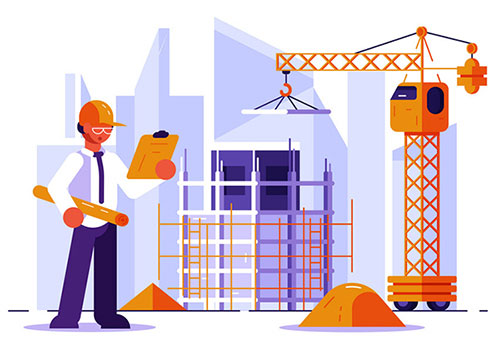VASTU ARCHITECTURE
Vaastu and Architecture
India, land of novelties of ancient architectures, and it's rich inheritance.
FOR VAASTU INTERNATIONAL COURSES - CLICK HERE
Vastu shastra works on the basic theme of Matter and Energy and describes the complete matrics of architecture, geometry of objects, orientation with respect to directions, measurements, proportions with view to the place and the occupant.
In Vastu shastra as well as modem architecture, the shapes like square and rectangle indicate safety, completeness and stability. But, the aesthetic shapes like triangle and rounded shapes representing grace and progress, which are popular in modern architecture, are avoided in Vastu shastra. Vastu shastra considers that the energetic space within a square or rectangular form create vibrations appropriate for peaceful and tranquil pattern of life.
TO KNOW MORE ABOUT 45 VASTU DEVTAS [ENERGY FIELDS] - CLICK ON BUTTONS

Architecture defines spaces and creates special forms in order to allot living spaces and utilitarian spaces amongst the occupants of a dwelling. Modern architecture sometimes gets so much obsessed with the ideas like economy, lifestyle, function, and efficiency that it almost forgets the inherent psychological needs like peace and tranquility of a human being occupying the structure.
Sometimes, the hands of an architect are forced because of professional compulsions like satisfying the demands of builders and developers. The individuality in architectural creations, visible in earlier times has in recent times been lost to problems associated with group or mass housing techniques.
Vastu shastra deals with four kinds of spaces - space within human form, constructed space, terrestrial space and cosmic space. A designer with Vastu shastra insight achieves harmony between all these spaces, and in the process creates microcosm in the built-up space that replicates the qualities of the macrocosm. Vastu shastra ideas result in design of houses, which are beneficial to the body and mind of the dweller.
Modern architecture, though outwardly elegant, is yet to imbibe the smooth way in which Vastu shastra has found balance between symmetry and asymmetry in designing structures. But the trends are changing. Architects have started borrowing from concepts of climatology, environmental engineering, and cosmic energy flow principles to design dwellings that are in harmony with nature and closer to Vastu shastra logic.
It is confounding/puzzling to note, that Vastu shastra and old cosmic diagrams (Mandala) are being dismissed in architecture as mere tradition and memory architecture. Vastu shastra is far beyond this process. Vastu shastra is a source of ideas and as such can be of great help during planning/Designing stage, construction stage, or finishing and decoration stage.
Vastu shastra encompasses the phenomenon of Pyramids, for correcting residential plots, These pyramids are energy generators at the centre. Experiments carried out on small pyramid models essentially conforming to the dimensions of the pyramid of Giza of have conclusively proved that, inside a pyramid a distinct atmosphere exists which is protective and energy giving.
Role of Shapes
In Vastu shastra, shapes like square and rectangle are popular for safety, completeness, and stability. Nowadays, architects are introducing round & triangular shapes in the structures to be constructed. But, in fact it is prohibited in Vastu shastra. Modern architecture is yet to digest the balance between symmetry / asymmetry which is evident in structures, designed as per Vastu shastra principles.
Vastu shastra & Modern Architecture
People, these days are more & more concern about their designs of structures to be built on the basis of Vastu shastra which would satisfy their logical & Psychological requirements by their architects. Certain important observations can be made as regards architecture being practiced today, as against concepts found in ancient texts on Vastu shastra.
The North Mark on architectural drawing
Marking the North direction on a drawing has now become a mere ritual / custom. The significance of the organic electromagnetic flux lines emanating from the North, is totally lost on the present day practitioners of architecture, who use North pointer for designating the roads and placement of plots. In ancient Vastu shastra practice immense importance was given to alignment of the geometric axis of the Vastu and the geomagnetic axis. Hence, the North flow and the North marking were paid special attention in planning of a Vastu. The energetic of the Vastu is influenced by the North flow, as discussed elsewhere on our website.
Windows and Openings
In the tropical countries like India, the path of the sun is normally along the East, Southeast, South, and Southwest directions. Almost throughout a year, we are directly exposed to the radiations of the sun. To keep the house in shady cool zone it is necessary to avoid the hateful radiations of solar radiations and, openings towards the South direction should normally be avoided. In old times this factor was given due consideration, and thickening of the walls on the South side and provision of entrances on the North side was a standard practice.
Water Pools in the North/North-East Zones
In most of our olden temples, a small lake of water or water pools were always found in the Northeast zone. This practice has a scientific base as far as dynamics of human mind are concerned.
Roof slopes
Generally the roofs slopes should be kept towards the North, Northwest & Northeast to protect excessive exposure of the area to solar radiations, leading to a very hot and unhealthy environment inside the dwelling.
The Directions
East - Directions of Organic Flow
Wide openings towards the East always channelise the Organic energy throughout the house. On the other hand, toilets and staircases in the East block the morning solar bliss.
Sunlight is essential for life processes and the natural synthesis of vitamin 'D' in human body largely depends on absorption of sunlight through the skin. Further, Yoga also suggests that early morning sunlight is a rejuvenator for the body. Ventilators / blinds and open spaces towards the East ensure that the entire house is exposed to the beneficial early morning sunlight for a maximum possible duration.
Large Openings to the Southwest
In tropical countries like us, the direction of the wind is generally aligned to the West, Northwest, and Southwest directions. The Indian Vastu concepts dismiss the wind as a carrier of dust and believe in creating shadow regions for cooler homes that do not need wind for ventilation. By providing thick walls in the South direction and openings in the North direction, the houses are made thermal radiation-proof. The concept of providing ample ventilation from the West may lead to air-borne diseases.
Symmetry and Discipline
The surfaces that receive the maximum solar radiation, apart from the roof areas, are the Southeast, South and Southwest walls. The Northeast, North, and Northwest walls are less exposed. As, most of India lies between the latitudes 90N and 350N. This implies that overall building form should be such that the exposure to the sun is minimized.
This is possible in buildings with shorter North and South walls and larger East and West walls. Vastu shastra principles talks about the length of North-South axis of a Vastu should be greater than the East-West axis.
Use of Local Materials in Construction
Houses built from locally available materials, are considered to give happiness through organic harmony and interrelationship between matter and energy spectrums.
These days we are turning ourselves towards eco-friendliness and environment. Environment can itself act as a source or a sink for natural resources, man-made products and Byproducts In his search for exotic materials for construction and decoration, man has created pollutants which did not exist in nature and which cannot be disposed off by nature. By utilizing local resources intelligently, it is possible to preserve the environment in a state of equilibrium and construct dwellings having maximum virtues as per Vastu principles.
Er. Rameshwar Prasad invites you to the Wonderful World of Vastu Architecture
Engineer Rameshwar Prasad(B.Tech., M.Tech., P.G.D.C.A., P.G.D.M.) Vaastu International
|








